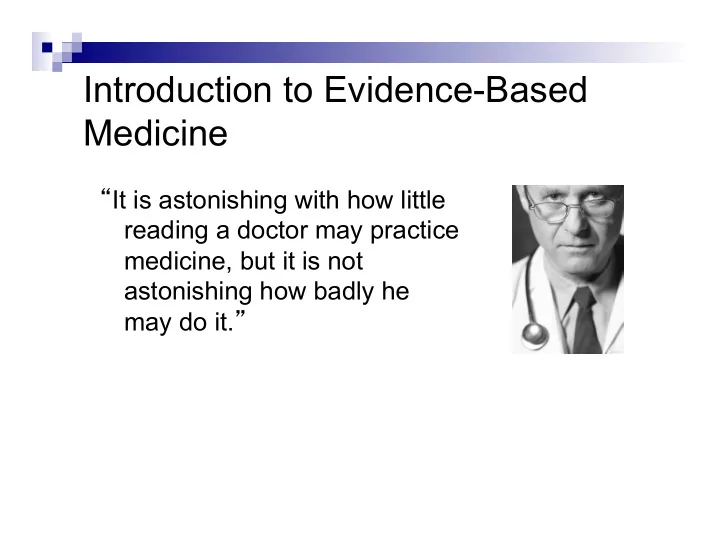

Introduction to Evidence-Based Medicine “ It is astonishing with how little reading a doctor may practice medicine, but it is not astonishing how badly he may do it. ”
Case 1 n 2 m/o, rural clinic T o = 103.4, exam otherwise WNL ¨ transportation: $5,000 (not covered) n Risk bacterial meningitis or other serious bacterial disease ~0.5% and 1.5% respectively; clinical guidelines provide solid evidence for close ambulatory f/u of low-risk infant (WBC 5-15K, no shift, nl U/A, <5 WBC per field if diarrhea)
Case 2 n 50 y/o construction worker with mallet finger n Dueling specialists
Case 3 n 2 patients same afternoon ask for HCV screen ¨ Married, monogamous male received 2 units whole blood in 1969 for ruptured spleen ¨ Single, female college student volunteers in day care impoverished area n Requirement for a screening test ¨ Condition c early recognizable phase ¨ Effective treatment available (improves prognosis) ¨ Relatively simple, not harmful and acceptable test ¨ Balance between false + and false -
The “ Birth ” of Evidence n Has always been a search for evidence ¨ Hippocrates, Galen, Fracastore, Paracelsus, Graunt, Farr, Louis, Snow, Cochrane n 1980s, Pauker, Kessiere – JAMA Series ¨ Clinical Decision Analysis, Sensitivity and Specificity, Pre-Odds x Likelihood Ratio n 1992, David Sackett gives birth to EBM ¨ Same concepts, accessible to clinicians ¨ Emphasized absolute vs ratio measures, e.g. NNT ¨ Hierarchical Evidentiary Pyramid n Role of Observational Studies?
The Problem: Keeping up With Medicine The slippery slope of knowledge 100 45 90 40 80 35 70 30 60 25 50 20 40 15 30 10 20 5 10 0 0 0 10 20 30 40 50 60 Journals ¡on ¡Aging: ¡ ¡1974 Journals ¡on ¡Aging: ¡1994 Y ears ¡S inc e ¡G rauatio n ¨ The slippery slope of knowledge n Best predictor of correct HTN Rx is # yrs from graduation ¨ Too many journals n 25,000 in print n Biomedical knowledge doubles q 19 yrs
Global Judgment by Experts n Experts see different patients ¨ 2 nd seizure after primary febrile seizure n 1.5 – 6% in population-based studies n 77% in seizure clinic studies n Geographic Variations (Wennberg) ¨ Tonsillectomy rates 8% in one Vermont county vs 70% in another ¨ Hysterectomy rates range from 20% to 70% in Maine
What about textbooks? n 2 years from manuscript preparation to publication n Several year lag between editions n In 1986 Harrison ’ s did not have an entry for AIDS
What about CME? n Didactic CME does not change MD behavior (Davis, JAMA 1999) n RCT of CME had no effect on clinical behavior (Sackett)
Implications n Outdated or incorrect treatments n Incorrect or missed diagnoses n Incorrect information n Costly, wasteful, and ineffective practice
Endarterectomy n Should a newly symptomatic pt. c severe carotid stenosis have endarterectomy? ¨ 8 out of 10 primary care docs said no ¨ 19/100 untreated will suffer major stroke or death ¨ 10/100 treated will have same complications ¨ Only have to treat 11 pts to prevent one stroke or death (clear and substantial benefit)
Lidocaine for PVCs n Once routine post-MI ¨ To prevent “ R on T ” V-tach n RCT showed increased risk of death in group randomized to prophylactic lidocaine n Other discredited treatments ¨ Routine tonsillectomy, phenobarbital for febrile sz ’ s, portal bypass procedure for esophageal varices, HRT
A Proposed Solution: Evidence- Based Medicine n Ask, Answer, Appraise, Apply n Ask: The PICO Approach n Answer and Appraise: ¨ PubMed http://www.ncbi.nlm.nih.gov/entrez/query.fcgi ¨ Ovid, SliverPlatter, ACP, Cochrane Collection n Diagnosis, Treatment, Prognosis, Harm
Ask: PICO
Answer: PubMed
Clinical Queries
Other Sources n Google ‘ Evidence Based Medicine ’ n Ovid n Silver Platter n American College of Physicians n Cochrane Collaboration
How to use PubMed Clinical Queries Diagnosis These are questions about the degree to which a particular test is reliable and clinically useful. Would your patient get enough benefit from the test (on average) to justify it ’ s being done. Most good studies of diagnosis compare the test under study to some “ gold standard ” or definitive test. Treatment What therapy is best for a particular patient, and what are the possible outcomes of different treatment options Prognosis Closely allied to treatment questions, prognostic questions are about a patient ’ s future health, and quality of life given a particular treatment option Harm Essentially questions of etiology; is a particular risk factor associated with a disease? How strongly? Can modifying risk factors have a benefit for your patient?
Help n When in doubt consult a medical librarian. n Trained in use of Filters, MESH Terms ¨ Note: Filters and MESH terms built into PubMed clinical query page n Aware of alternative sources
Recommend
More recommend